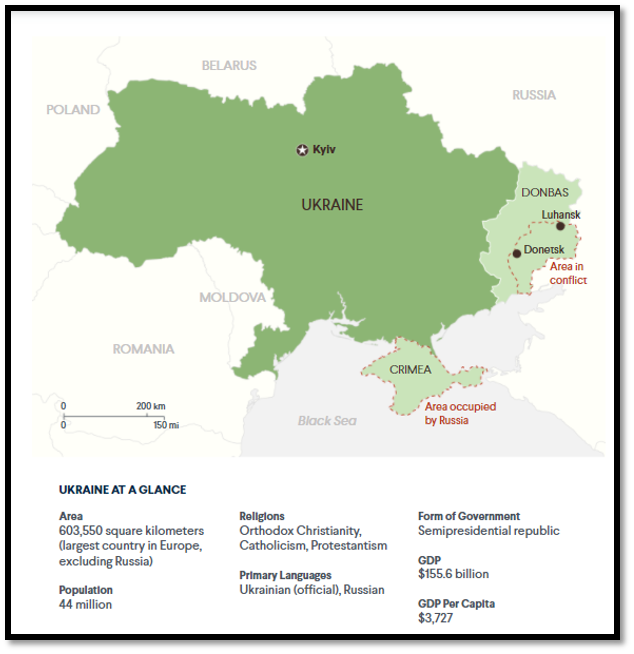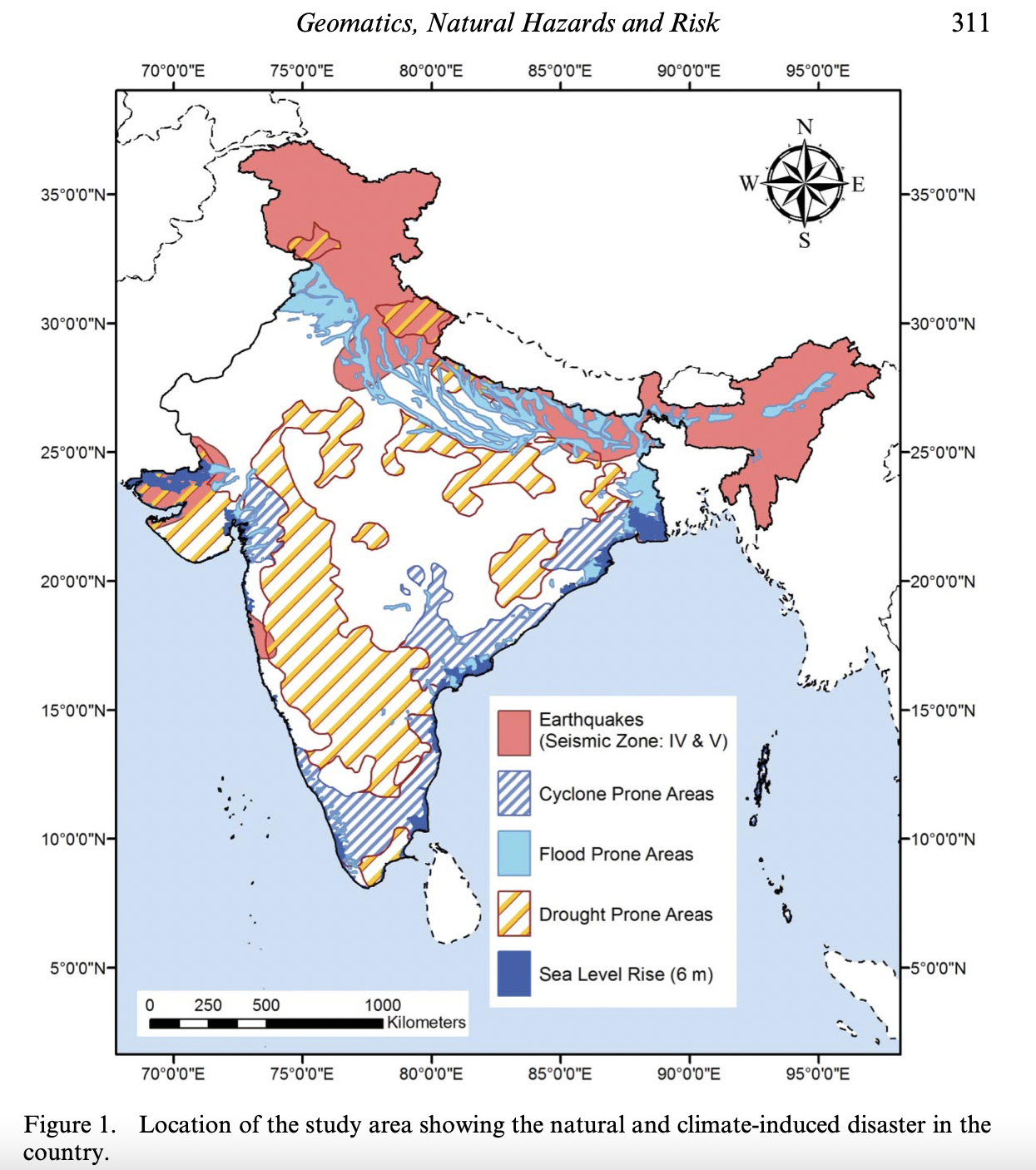12 Mar
Feature #1: IPCC Working Group II Report (Part 1: Impacts and risks generated by climate change)
In News
The Working Group II report of the United Nations’ Intergovernmental Panel on Climate Change (IPCC) is released.
What is the Working Group II report?
- This report is part of the IPCC’s latest assessment cycle – the sixth set of “assessment reports” (AR6) since its foundation in 1988. The previous set – the fifth assessment report (AR5) – was published in 2013-14.
- IPCC’s efforts for AR6 are divided into three “working groups”:
- Working Group I (WG1): The physical science basis
- Working Group II (WG2): Impacts, adaptation and vulnerability
- Working Group III (WG3): Mitigation of climate change
- The WG1 report was published in August 2021. The WG3 report is expected to be published this year, followed by a synthesis report.
- WG1 assessed increase in global surface temperature is 1.09°C in 2011-2020 above 1850- 1900. The estimated increase in global surface temperature since AR5 is principally due to further warming since 2003–2012 (+0.19°C).
- There is at least a greater than 50% likelihood that global warming will reach or exceed 1.5°C in the near‐term, even for the very low greenhouse gas emissions scenario.
- Specifically, the aim of the WG2 report is to address “the challenges of climate action in the context of sustainable development with a particular focus on climate change impacts, adaptation and vulnerability”.
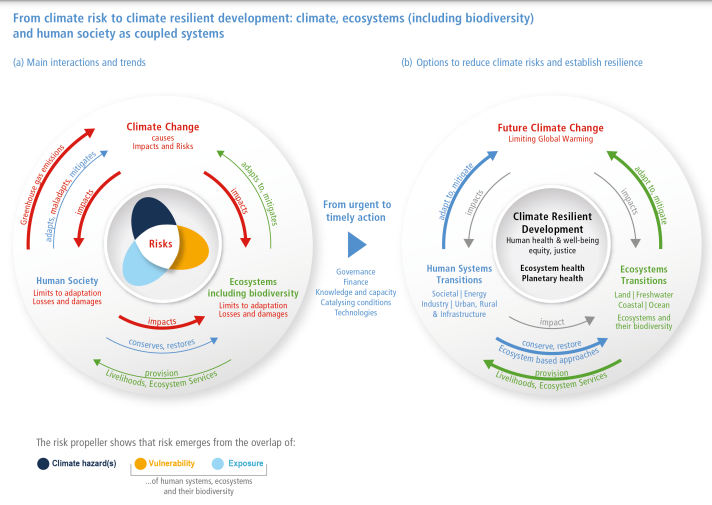
Special Note for Reader:
This report is divided into two parts: (i) Impacts and risks generated by climate change and (ii) Adaptation, Loss & Damage, and Climate Resilient Development
In this issue we shall present the Part 1. This covers the risks posed by climate change across various ecosystems and regions. It also includes an India specific section explaining various risks. The second part shall be covered in next issue of KOSMOS.
Key Findings of the Report
Since AR5, the knowledge base on observed and projected impacts and risks generated by climate hazards, exposure and vulnerability has increased with impacts attributed to climate change and key risks identified across the report. Impacts and risks are expressed in terms of their damages, harms, economic, and noneconomic losses. Risks from observed vulnerabilities and responses to climate change are highlighted.
How is climate change affecting land ecosystems?
Fauna
- It is very likely that climate change has brought changes to the geographic ranges, physiology and morphology of land species as well as animal “phenology” – the timing of key life events.
- Shifting Geographic Ranges: Half of all land species studied have shifted their geographic ranges in response to “regional climate changes, thus altering the make-up of ecosystems and increasing spread of invasive species.
- Increasing Wildlife Diseases: Climate change has increased wildlife diseases attributed to temperature rise and more brutal extreme weather events. In countries close to the Arctic, climate change has helped vector-borne diseases that infect humans.
- Forest insect pests are causing greater damage in northern North America, Europe, and Asia due to warmer winters reducing mortality and longer growing seasons.
- Threat of wildlife Extinction: A study of 976 plants and animals found that 47% had suffered local extinctions as a result of climate-induced changes.
- Climate change could have played a role in the extinction or near-extinction of at least three species-the white ringtail possum in Australia, the Bramble Cays Melomys at the northern tip of the Great Barrier Reef and the cloud-forest-restricted Golden toad in Costa Rica.
Flora
- Biome Shifts: There is increasing number of biome shifts and structural changes within ecosystems. This includes upward shifts to alpine and boreal forests and more trees in the sub-Arctic tundra.
- Wildfires: A combination of climate change, shifts to grazing, and fire management is causing trees to encroach further into grasslands and savannahs. A quarter of the world’s natural land now sees longer fire seasons as a result of increases in temperature, aridity and drought.
- Human-caused climate change has contributed to a doubling of area burned by wildfires across the western US since the 1980s.
- Forest area burned by wildfires has also increased in the Amazon, the Arctic, Australia and parts of Africa and Asia. However, these increases have not formally been linked to climate change.
- Mass Tree Mortality: Climate change is causing mass tree die-offs through its impact on droughts. It has potentially contributed to 100 cases of drought-induced tree die-off across Africa, Asia, Australia, Europe and the Americas.
- Soil Carbon: Despite humanity’s impact on land, it still stores more carbon than it emits each year. The land currently stores around 3.5tn tonnes of carbon, three-to-five times more than the amount stored by unextracted fossil fuels and four times more than what is currently in the atmosphere.
Prediction
- It is likely that the proportion of all species at very high risk of extinction (categorised as “critically endangered” by the IUCN Red List) will reach 9% (maximum 14%) at 1.5°C, 10% (18%) at 2°C, 12% (29%) at 3°C, 13% (39%) at 4°C and 15% (48%) at 5°C.
- Insects (particularly pollinators), amphibians and flowers face the biggest extinction risks. Loss of species reduces ecosystem’s ability to provide services and lowers its resilience to climate change.
- At 4°C of global warming, more than a third (35%) of the global land surface could witness biome shifts. This could be limited to less than 15% if temperatures are kept below 2°C.
- This level of warming could see large swathes of the Amazon rainforest shift to drier, less dense vegetation, further poleward shifts of boreal forests into the Arctic tundra and upslope shifts of mountain forests into alpine grasslands.
- The impact of climate change on ecosystems could “substantially” increase the release of land carbon in the atmosphere, prompting “self-reinforcing” feedback loops. “
What impact is global warming having on marine life?
- Human-driven chemical and physical changes to the ocean are altering the distribution and abundance of marine organisms from microbes to mammals and from individuals to ecosystems.
- As the oceans warm, marine species are being forced out of their natural habitats, generally along the pace and direction of climate warming. Since 1950s, these poleward shifts are happening at a rate of almost 60km per decade.
- Warming is also affecting the timing of key biological events, such as phytoplankton blooms, commercial fish spawning and marine reptile breeding.
- Warming exacerbates the effects of other stressors. The report divides these into “climate-induced drivers” and “non-climate drivers”.
- Other climate drivers include ocean acidification and deoxygenation, while non-climate drivers include pollution, overfishing, invasive species and habitat degradation.
- Overexploitation of fisheries also has a significant impact on fishery yields.
- Marine heatwaves can lead to “mass mortality” events among “key foundational species”. In “most regions”, seaweeds such as kelp are already experiencing such mass mortality events, along with range shifts.
- This is partially due to the direct effects of warming and partially due to indirect effects, such as changing ranges of plant-eating species.
- The report warns of “irreversible phase shifts” in these ecosystems if 1.5°C warming is surpassed and that they are at “high risk”, even if warming is kept to below 1.5°C.
- Coral reefs, which are home to one-quarter of marine biodiversity, face a range of threats from both climate and non-climate drivers.
- Increasingly frequent and severe heat stress has increased both mass bleaching events and disease outbreaks.
- With warming above 1.5°C, reefs are under threat of reaching erosion rates larger than the rate at which new corals can grow.
- Ocean acidification is also decreasing both coral cover and diversity; these effects can be exacerbated by warming.
- Other calcifying organisms, such as mussels and oysters, are also at “high risk of decline” due to a combination of climate stressors.
- Continued warming, acidification and sea level rise will increase the risk of both regional and global extinctions of certain species – even if warming is limited to less than 2°C by the year 2100.
- Another major climate driver is hypoxia, or low oceanic oxygen levels. Hypoxia is caused by the decreased solubility of oxygen in warmer waters as well as increased respiration rates of marine microbes and changes in the circulation of the ocean.
- Low-oxygen zones are increasing in both size and number around the world with growing impacts on fish species diversity and ecosystem functioning.
- Declining oceanic oxygen levels have already decreased suitable habitat for important open-water fish species such as tuna by 15%.
- Organisms whose habitats are more “thermally stable”, such as the Polar Regions or the deep sea are often more sensitive to warming than those from environments with more temperature variation. Warming has contributed to “major community shifts, both gradual and abrupt” in fish, marine mammals and seabirds in the Polar Regions.
- There are projections of decline in global net primary production – the net carbon gained by phytoplankton and other plants in the ocean – by 2080-99 as compared to 1996-2015 levels.
- Global models also project a loss in marine biomass (the total weight of all animal and plant life in the ocean).
How is climate change affecting the world’s water?
- Nearly 50% of world’s population experiences severe water scarcity for at least 1 month per year.
- Since 1970s, 44% of all “disaster events” on Earth have been flood-related. Heavy rainfall intensity has increased in many regions since 1950s affecting around 700 million people living in these areas.
- In northern hemisphere, snow cover is decreasing since 1970s. Over the past two decades, the loss of ice from glaciers has exceeded 0.5 metres of water equivalent each year.
- Glacier mass change rate has been highest in the western US and Canada, Iceland and Svalbard.
- The melting of glaciers is impacting “humans and ecosystems”, including “vulnerable high mountain and polar communities”.
- Case Study: Changing ice conditions in the Canadian Arctic have affected access to trails for Inuit communities. Also, the melting of ice has affected Alaskan Native populations’ access to culturally-significant species.
- There is a clear trend of increases to stream flow in rivers in the northern high latitudes. Meanwhile changes to groundwater stores are less straightforward.
- Groundwater storage has declined in many parts of the world, largely due to a growing demand for water for crop irrigation.
- In higher altitudes, warming has altered groundwater levels, which may have played a role in reduced spring-time recharge.
- Human-caused climate change affected global patterns of soil moisture over the 20th century, with consequences for agriculture, ecosystems and the severity of extreme weather events.
- Between 1970 and 2019, 7% of all “disaster events” were drought-related. However, drought disasters accounted for 34% of disaster deaths, particularly in Africa.
- Meanwhile, severe rains made more likely by climate change have caused catastrophic flooding in areas such as western Europe, China, Japan, the US, Peru and Brazil since 2014.
- Changes to the water cycle are impacting agriculture. Between 1983 and 2009, around three-quarters of the global harvested area experienced yield losses because of drought, costing the world an estimated US$166bn.
Projection:
- At 2°C of global warming, 3 billion people could face water scarcity.
- Extreme agricultural drought across large areas of North and South America, the Mediterranean and Eurasia is projected to be twice as likely at 1.5°C.
- Risks to agricultural yields from temperature and water changes could be three times higher at 3°C rather than 2°C.
- Direct flood damages could be four to five times higher at 4°C of global warming rather than 1.5°C.
- GDP losses related to flooding could be 1.2-1.8 times higher at 2°C warming rather than 1.5°C.
- At 4°C of global warming, around 10% of the global land area, supporting 2.1 billion people could face increases in extreme stream flow.
- Some parts of Europe, including the Mediterranean, could see the potential for hydropower decrease by 40% at 3°C, compared to 10% at 2°C and 5% at 1.5°C.
What does the IPCC report say about impacts on food and agriculture?
- Climate change impacts – including weather extremes, such as droughts, floods and marine heatwaves – are putting strain on agriculture, aquaculture, forestry and fisheries.
- Each step in the supply chain from production to consumption, including storage and transportation, will also be affected by climate change.
- Sudden food production losses due to extreme events have been increasingly frequent since at least mid-20th century.
- Under the very high emissions scenario, about one-third of “currently suitable area” is projected to become unsuitable by the end of the century.
- Crops are negatively affected by climate change in several ways. One study estimated nearly a 10% yield reduction in four major crops between 1850 and 2010, even when taking into account the “positive effect” of CO2 fertilisation.
- In addition to the yield reductions, elevated levels of CO2 have been shown to reduce important nutrients including protein, iron and zinc in a wide range of plants.
- The specific impacts of climate on agriculture vary by crop and by region. In eastern Asia and northern Europe, climate change has so far increased wheat yields, while its effects are “mostly negative” on crop yields and quality across sub-Saharan Africa, South America, the Caribbean, southern Asia and western and southern Europe.
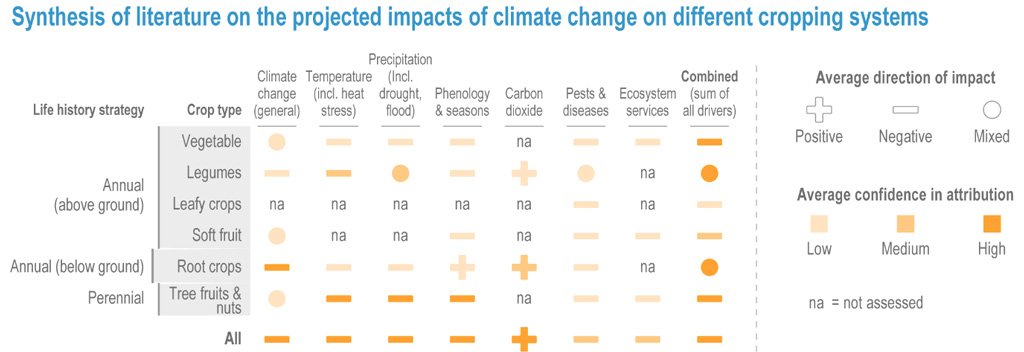
- Changes in the reproductive rates and distributions of pests, pathogens, weeds and disease vectors will increase the stress on both crops and livestock under future climate change. Since 1960, there have been “significant poleward expansions” of many key crop pests and pathogens.
- In addition to reducing yields, pests and pathogens can increase post-harvest food losses.
- Climate change is already impacting livestock production through both “direct impacts” – increased mortality due to heat stress – and “indirect impacts”, such as reducing the quality of grasslands used for grazing.
- Drought, rising temperatures and other drivers are “reducing herd mobility, decreasing productivity, increasing incidence of vector borne diseases and parasites and reducing access to water and feed”.
- Warming of 2°C by 2050 is projected to result in 7-10% declines in livestock numbers globally.
- Warming, ocean acidification and declining oxygen levels will all have negative impacts on key fisheries and aquaculture species, while inland and coastal aquatic systems will additionally be affected by sea level rise.
- Climate change’s impacts on fisheries will be particularly high in tropical regions due to large reductions in catch.
- These changes can have significant consequences for human nutrition, particularly in lower-income countries where fewer nutritional alternatives are available.
- Drought-related crop loss has increased in recent years, and has affected about 75% of the global harvested area.
- The report also warns of the risk of “multi-breadbasket failures”, in which synchronous droughts or other extreme weather events affect crop production in multiple regions of the world.
- Social inequalities, such as gender, socioeconomic status, and ethnicity, can compound vulnerability to the effects of climate change for both producers and consumers.
- Women are more vulnerable to climate-related food insecurity than men and Indigenous livestock keepers are at higher risk than their non-Indigenous counterparts due to historical land dispossession, discrimination and colonialisation.
- Climate change is already affecting all dimensions of food security: availability, access, utilisation (food quality and safety) and stability.
- The number of people at risk of “hunger, malnutrition and diet-related mortality” will increase in the future. Nearly 80% of this at-risk population is projected to occur in Africa and Asia.
- There are various adaptation options currently feasible and effective at reducing climate impacts. These include sustainable resource management, incorporating Indigenous and local knowledge and diversifying crops and species. However, there are many financial barriers to implementing these options and vastly more public and private investment is required to do so.
What risks does climate change pose to the world’s cities?
- Urban areas are home to more than half of the world’s population. Between 2015-20 urban populations grew by more than 397 million people – with more than 90% of growth situated in less developed regions.
- By 2050, an additional 2.5 billion people could be living in urban areas. Roughly 90% of this increase is expected to be in Asia and Africa – with India, China and Nigeria alone responsible for 35% of the growth.
- “Unplanned and informal” cities – particularly in Asia and Africa – have expanded rapidly. More than half of the urban population in sub-Saharan Africa and nearly one-third of South Asia’s urban population were living in informal housing in 2018.
- Cities are often hotspots for climate extremes, such as heatwaves and flooding – due to a combination of their location, population density and concentration of buildings and infrastructure.
- For example, most of the population exposed to heatwaves in the coming decades will live in urban regions – in large part because the urban heat island effect can add 2°C to local warming.
- Cities in mid-latitudes are particularly at risk from rising temperatures and could be subject to twice the levels of heat stress compared to their rural surroundings by 2050.

- The urban expansion and changing rainfall patterns could cause nearly one third of all “major cities” worldwide to exhaust their current water resources by 2050.
- Flooding is a key issue for cities. Many cities are located near the sea, increasing the risk of coastal flooding: nearly 11% of the global population, or 896 million people, already living on low-lying coasts directly exposed to interacting climate- and non-climate coastal hazards.
- By 2050, more than a billion people located in low-lying cities and settlements will be at risk from “coastal-specific climate hazards”.
- Between $7-14trillion of coastal infrastructure assets will be exposed by 2100, affecting sectors including transportation, housing, power production, and information technology.
- Population growth will also be a key driver of increasing flood risk – as economic development is disproportionately concentrated in and around coastal cities and settlements.
- Urban land exposed to floods and droughts will increase by more than 2.5 times between 2000 -2030.
- Coastal regions with fast-growing populations in Africa, Southeast Asia and small islands will be particularly at risk of flooding over the 21st century.
- Demographic change, social and economic pressures and governance failures that drive inequality and marginality mean that increasing numbers of people who live in towns and cities are exposed to flooding, temperature extremes and water or food insecurity.
- This leads to an adaptation gap, where rich neighbourhoods can afford strategies to reduce vulnerability while poorer communities are unable to do the same.
- The issue of air pollution in cities: 95% of the global population currently lives in regions where fine particulate matter (PM2.5) floating in the air exceeds the WHO guidelines.
- Future emissions of air pollutants will broadly decline by 2050, as societies become wealthier and more willing to invest in air pollution controls.
- Whereas cities in East Asia and South Asia currently have large exposure to anthropogenic air pollution, African cities may emerge by 2050 as the most polluted because of growing populations and demand for energy, increased urbanisation, and relatively weak regulations to control emissions.
What does the IPCC report say about public health, conflict and migration?
Public health
- Extreme heat is linked to severe dehydration, organ failure, cardiovascular disease and even death. Parts of India, Persian Gulf, Gulf of California and southern Gulf of Mexico are especially hard hit approaching the upper limits of labour productivity and human survivability.
- Extreme weather events, such as heatwave, wildfires, floods and droughts, are already becoming more frequent and intense – driving rising mortality rates. Over 1998-2017, there were 526,000 deaths from 11,500 extreme weather events globally.
- Disruption to infrastructure and basic services in the aftermath of extreme weather events is often associated with increased violence against women, girls and vulnerable groups.
- Climate is also a driving factor to spread a range of diseases. E.g., the range of mosquitoes is expanding as temperatures rise, allowing dengue and malaria to spread to new areas.
Projections
- By 2050, an extra 250,000 deaths will occur each year from climate-sensitive diseases. Excess deaths will be dominated by heat deaths in Asia and high-income countries, childhood undernutrition and diarrheal disease in Africa and Asia and malaria in Africa.
- Overall, more than half of the excess mortality will be seen in Africa.
- Covid-19 has “aggravated climate risks”. For example, when extreme events struck, social distancing rules reduced the capacity of temporary shelters. The pandemic shows “the interconnected and compound nature of risks, vulnerabilities, and responses to emergencies”.
Conflict and Migration
- Climate hazards are a growing driver of involuntary migration and displacement and are a contributing factor to violent conflict.
- Extreme weather events can drive migration in two ways– for example, directly through a cyclone destroying a house, or, for example, indirectly from long-term losses due to drought.
- Most climate-related migration occurs within national boundaries with an average of 20 million people per year have been displaced internally by weather-related extremes since 2008.
- Storms and floods rank as the most common drivers of displacement.
- South, east and south-east Asia have seen the highest number of people displaced per year – largely to tropical cyclones and “extreme storms” – followed by sub-Saharan Africa.
- Small-island states in the Caribbean and South Pacific are disproportionately affected, relative to their small population size.
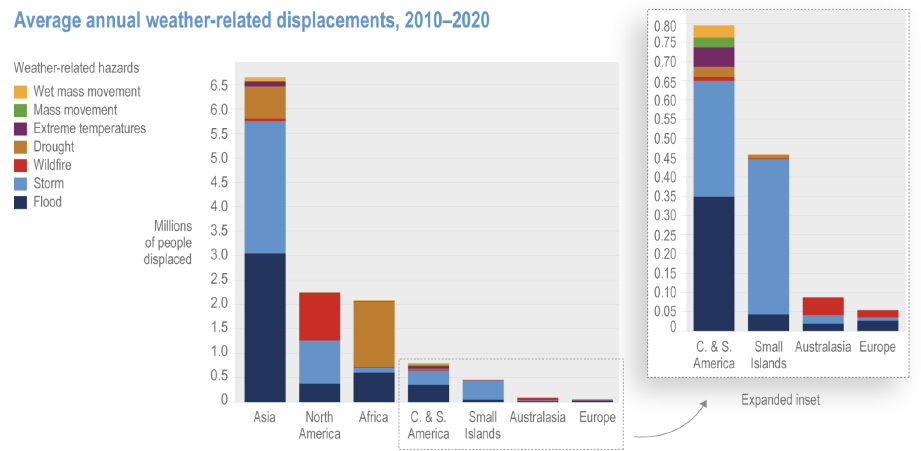
- Refugee and internally displaced people settlements are disproportionately concentrated in regions exposed to higher-than-average warming levels and specific climate hazards such as the Sahel, the near east and central Asia.
- As the planet warms, migration is likely to increase. For example, for every 1°C of extra warming, the global risk of involuntary displacement due to flooding increases by 50%.
- For example, displacement in Latin America, sub-Saharan Africa and South Asia by 2050 could vary between 31-143 million people depending on future emissions and socioeconomic development trajectories.
- Gender inequality in migration: Women tend to suffer disproportionately from the negative impacts of extreme climate events for reasons ranging from care giving responsibilities to lack of control over household resources to cultural norms for attire.
- Climate change is also expected to reduce water availability. Limited water availability can exacerbate tensions. For example, in Syria, drought has aggravated existing water and agricultural insecurity. However, whether drought caused civil unrest in Syria remains highly debated.
- 2°C warming would increase the probability of “conflict risks” by 13%, due to reduced food and water security, and disruption to lives and livelihoods.
- This instability can lead to “civil unrest” in some regions, which is often linked to an increase in violence against women, girls and vulnerable groups.
How does climate change affect poverty and progress towards the sustainable development goals?
- Climate change impacts tend to worsen inequality, given that they disproportionately affect people who are disadvantaged and, therefore, reduce their ability to cope and recover.
- Lost agricultural income and the impact of hazards on health are the key factors that drive disproportionate impacts on the poor.
- Additionally, groups that face disadvantage due to discrimination, gender and income inequalities and lack of access to resources could have fewer resources to prepare, react, cope and recover from adverse climate change impacts “and are therefore more vulnerable”. This vulnerability can then increase due to climate change impacts in “a vicious cycle”.
- A key risk for the poor is “shocks to specific livelihood assets”, such as land and housing, with the urban and rural landless poor struggling to rebuild them after disasters.
- Climate change impacts drive recurrent poverty and force the poor into persistent extreme poverty traps. This is especially true when wages remain stagnant, costs of living, such as food and healthcare, rise, mobility is restricted and when people face ethnic or social discrimination or conflict.
- Average mortality from floods, drought and storms over the past decade was 15-times higher for “very highly vulnerable” regions and countries – including Mozambique, Somalia, Nigeria, Afghanistan and Haiti – versus regions and countries ranked “very low” on the scale of vulnerability, such as the UK, Australia, Canada and Sweden.
- The most vulnerable regions in the world include east, central and west Africa, south Asia, Micronesia and Melanesia and Central America. It estimates that 1.6 to 3.3 billion people are living in countries classified as very highly or highly vulnerable, while 0.8 to 2 billion people reside in regions classified as least vulnerable.
- Of all climate hazards, warming trends and drought “pose greatest risks to the widest array of livelihood resources.
- Unlike other hazards that impact largely “private livelihood resources”, such as houses and incomes, droughts and warming also affect common pool resources, such as rangeland, fisheries and forests.
- Multiple hazards “undermine” these ecosystems that Indigenous Peoples rely on for food security and “have sustainably managed over the long-term”.
- By 2030, the number of people living in extreme poverty is set to increase by 122 million.
- Climate change and vulnerability together “threaten the achievement of the UN Sustainable Development Goals (SDGs)”, especially progress towards goals such as no poverty (SDG1), zero hunger (SDG2), gender equality (SDG5) and reducing inequality (SDG10).
- For example, a 2021 study from India shows increased risk of intimate partner violence after climate disasters. Societies vulnerable to climate change may need to prepare for the social disasters that can accompany disasters revealed by natural hazards.
- The report observes that while “ordinary communities” displayed unprecedented degrees of resilience – including behavioural and attitudinal shifts and technological innovation – ‘gated adaptation’ by elites only enhanced inequality in access to water.
- Case study: African cities must plan for slow-onset shocks and integrate equity and sustainability into disaster planning, while ensuring water tariff models are flexible enough to prioritize urban poor and do not deepen existing inequalities.
- Migration, infrastructural changes or pursuing alternative livelihoods due to irreparable loss and damage indicate that community or household actions can only address “typical challenges”, such as seasonal shifts in rainfall.
- However, they are less effective in addressing extreme events that have long-lasting impacts, indicating limits to “autonomous” – spontaneous, unplanned – adaptation by affected communities.
- Principle of “common but differentiated responsibilities and respective capabilities” (CBDR-RC) is closely linked to climate justice and acknowledging countries’ different development situations.
- There has been a continued heavy imbalance in favour of mitigation finance, with adaptation receiving only 5% of tracked climate finance, around $30bn (compared to $532bn for mitigation).
- Multilateral and bilateral donors often fail to prioritize highly vulnerable countries for adaptation projects and that foreign funding may lead to the dominance of donor-led governance models.
- A 2017 study estimates that less than 10% of climate finance committed from international, regional and national climate funds went to locally focused projects in developing countries between 2003 and 2016.
- The report lists Burkina Faso, Mali and Zambia not only among the “most vulnerable to climate change”, but “least able to mobilise the finance needed to adapt to its impacts”.
- Mali still reels from the effects of a drought in 1982-84, showing that climate change can have persistent impacts on livelihoods and food security long after an extreme event has passed.
- They also note that least developed countries (LDCs) and small-island developing states (SIDs) currently receive only 14% and 2%, respectively, of total climate finance.
- Vulnerable, developing countries shoulder additional debt burden linked to their exposure to climate risks. This is further exacerbated by the Covid-19 pandemic.
- Debt relief by public creditors, green recovery bonds, debt-for-climate swaps or SDG-aligned debt instruments could help vulnerable countries address their debt burden.
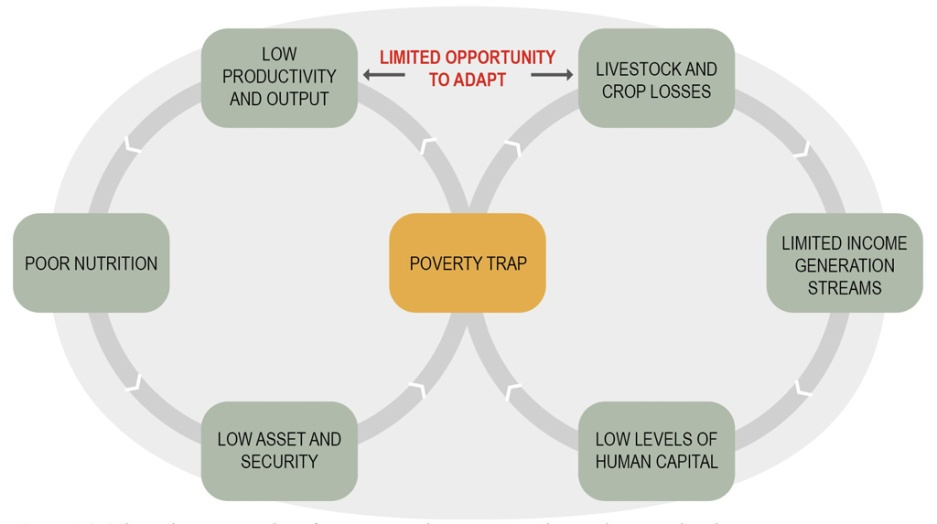

Feature #2: Regional Impacts of Climate Change and Global Warming
Background
- The AR6 WG2 report contains discussion on regional climate information. The report’s very strong regional focus is one of the key developments since AR5. These regional chapters highlight the current and future impacts of climate change, including the impacts on:
- Regional temperatures
- Extreme weather events
- Food and water security
- Migration
- Health and diseases
- The economy and livelihoods
Regional associated risks
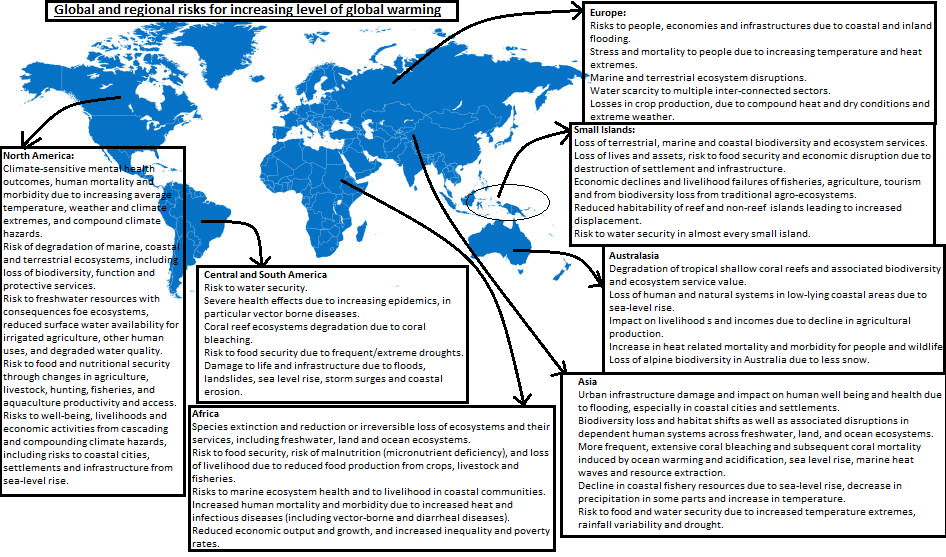
Regional Impacts: Case Studies
|
Region |
Case study |
Map |
|
Australia: The Great Barrier Reef in Crisis |
|
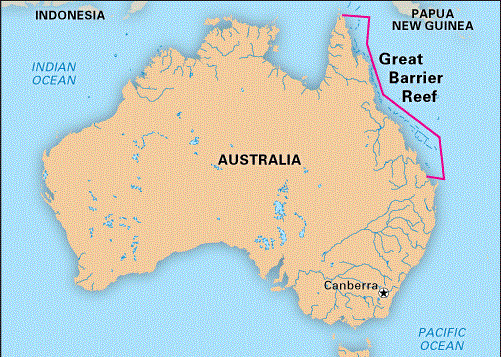 |
|
Africa: The Cape Town Drought (2015-2018) |
Anthropogenic climate change made the drought five to six times more. After three consecutive years of low precipitation, Cape Town braced for a ‘Day Zero’ where large portions of the city would lose water supply. The risk of day zero was anticipated to cascade to affect risks to health, economic output and security. |
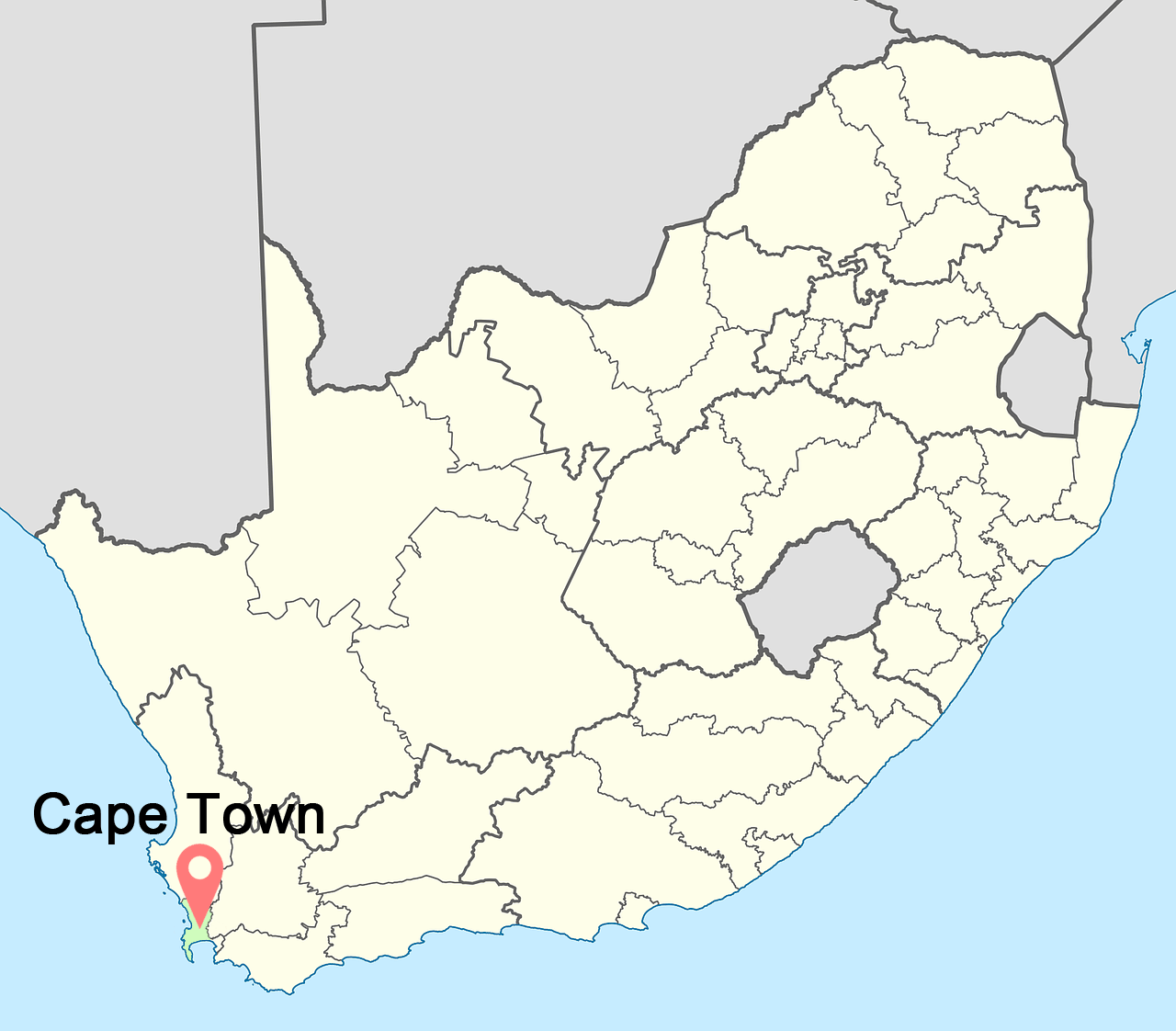 |
|
Asia: Sand and Dust Storm, Climate Change, in West Asia, Iran |
Iran is mostly arid or semiarid, with deserts making up at least 25 million hectares of the country’s area. Iran is experiencing unprecedented climate-related problems such as drying of lakes and rivers, dust storms, record-breaking temperatures, droughts, and floods. There are three key factors responsible for the generation of sand and dust storms – strong wind, lack of vegetation and absence of rainfall. It seems that it is closely related to the heating surface and the occurrence of local dry instabilities. |
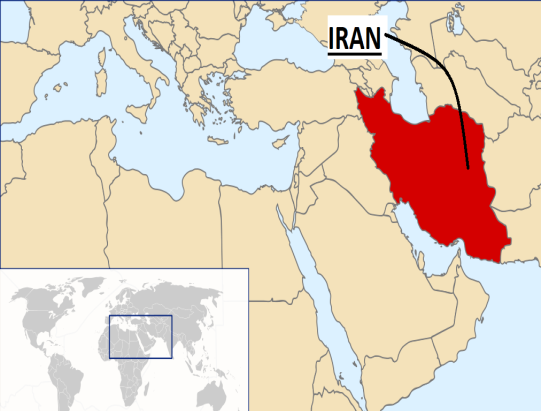 |
|
Central and south America: Guatemala |
Guatemala experiences high climate inter-annual variability now increased from the effect of climate change. Impacts on human settlements, agriculture and ecosystems result from both excess and reduced precipitation. Deficient integrated water resource management in the country is the main reason for those impacts. |
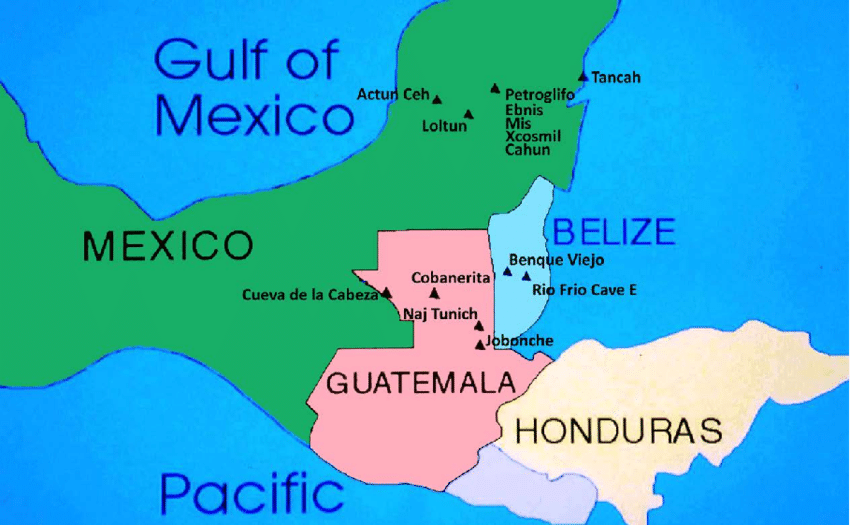 |
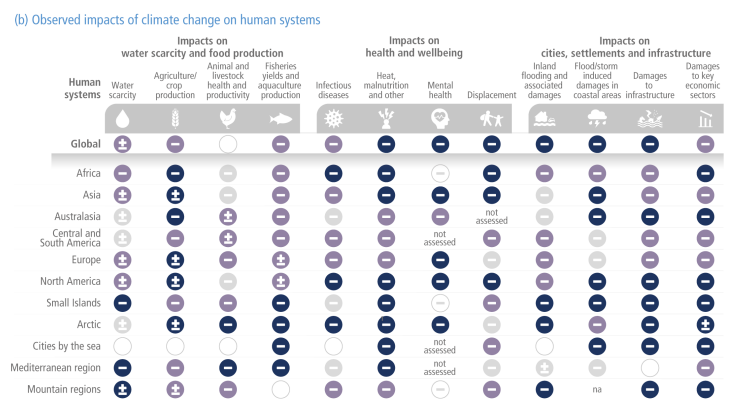
Feature #3: Vulnerability of India
Introduction
- India has almost all the world’s agro-ecological zones. The three major climate change hotspots are the semi-arid and arid regions, the Himalayan ecosystem and Coastal zones.
- India, owing to its geography and population, remains among the most vulnerable countries on the planet. From economic shocks and affected human survivability, to impacted food production and shortage of other vital resources, the nation is staring at a broad spectrum of disastrous consequences.
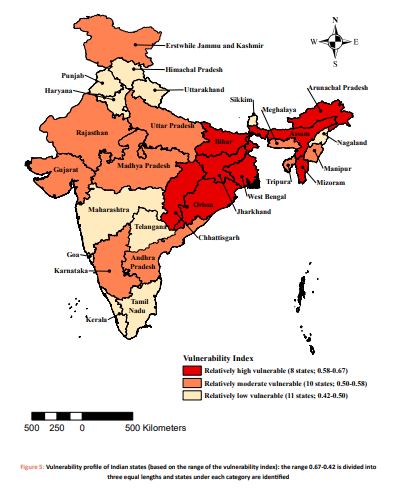
Key India-specific impacts highlighted by the 2022 IPCC report
- Impact of sea-level rise on coastal areas
-
- Globally, India is one of the most vulnerable countries to sea-level rise, which will result in more land getting submerged, regularly flooded, eroded, or becoming unsuitable for agriculture due to saltwater intrusion.
- A majority of these consequences will be restricted to the coastal areas — a disastrous prospect, considering India’s 6-km-long coastline and the dense population.
- By the middle of the century, around5 crore people in India could face annual coastal flooding, with 4.5 to 5 crore at risk by the end of the century if emissions are high.
- The economic costs of sea-level rise and river flooding for India would also be among the highest in the world.
- Sea level rise and increases in tropical cyclone storm surge and rainfall variability leading to a rise in the intensity of rainfall will lead to larger probabilities of cities getting flooded.
- The report predicts that there is evidence that changes in high-intensity short duration (sub-daily) rainfall in urban areas will increase. Places like Mumbai, Chennai, Kolkata, Visakhapatnam, Goa, the Andaman and Nicobar Islands and smaller coastal towns and villages are at a greater risk of being flooded.
- Reduced labour capacity
-
- About half of India’s landmass is arid and semi-arid, prone to impacts of rising temperatures.
- Rising emissions will result in India experiencing intolerable heat conditions, which the report refers to as 'wet-bulb temperatures' — a measure that combines heat and humidity. The figure predicted for India is 31°C, which is extremely dangerous for humans.
- Lucknow and Patna are among the cities predicted to reach wet-bulb temperatures of 35°C at the end of the century if emissions continue to rise. Bhubaneswar, Chennai, Mumbai, Indore and Ahmedabad are all identified as at risk of reaching wet-bulb temperatures of 32-34°C with continued emissions.
- Overall, Assam, Meghalaya, Tripura, West Bengal, Bihar, Jharkhand, Odisha, Chhattisgarh, Uttar Pradesh, Haryana and Punjab will be the most severely affected, but if emissions continue to increase, all Indian states will have regions that experience wet-bulb 30°C or more by the end of the century.
- Heat will reduce labour capacity, particularly in agriculture. The country’s agricultural labour capacity will fall by 17% if warming continues to 3°C — only a little more than the currently planned emissions would lead to — or 11% if emission cuts are accelerated.
- Drop in crop production
-
- The report has identified India as the most vulnerable country in terms of crop production.
- Rice, wheat, pulses and coarse cereal yields could fall almost 9% by In South India, maize production could decrease by 17% if global temperature rise continues at a higher rate.
- Water scarcity
-
- The changing climate, coupled with rising demand, could mean that about 40% of the people residing in India will live with water scarcity by 2050, as compared to 33% of the population at present, according to a study cited by the report.
- It is also estimated that both the Ganga and Brahmaputra river basins will witness increased flooding due to climate change.
- Also, global warming has increased the average temperature in the Himalayas, which has caused glacier melt and subsequent change in hydrological regimes of the region.
- One of the contributing factors of glacial decline is the deposition of black carbon, which is contributed by stubble burning, brick kilns, polluting industries.
- Water insecurity in hill towns is becoming the order of the day. India needs to re-adopt its traditional adaptation solutions.
- Decline in fisheries
-
- Continued climate change will also affect India's fisheries. Key commercial species such as hilsa, shad and Bombay duck are projected to decline dramatically if temperatures continue to rise.
- The energy harnessed by marine plants and algae — crucial for strong fisheries — has already declined by 20% in the last 60 years in the western Indian Ocean, due to climate change reducing the nutrient mixing between ocean levels.
- Severe economic damage
-
- According to a study cited by the IPCC report, India is economically harmed the most by climate change, with every tonne of carbon dioxide emitted globally costing the country around $86.
- Since 1991, India's GDP per capita has already been 16% lower than it would have been without human-caused warming. But if the warming continues unabated, then by 2100, the country’s average income could be 92% lower than what it would have been without climate change.
Conclusion
This report has a strong focus on the interactions among the coupled systems climate, ecosystems (including their biodiversity) and human society. These interactions are the basis of emerging risks from climate change, ecosystem degradation and biodiversity loss and, at the same time, offer opportunities for the future. The recognition of climate risks can strengthen adaptation and mitigation actions and transitions that reduce risks.
|
Key Definitions in the IPCC Report
|
Where to Use
Geography P1- Environmental Geography
Geography P2- Contemporary Topics
GS P1, P3, Essay
Reference
- IPCC_AR6_WGII_Summary For Policymakers
- In-depth Q&A: The IPCC’s sixth assessment on how climate change impacts the world
- https://dst.gov.in/sites/default/files/Full%20Report%20%281%29.pdf (Page 16 for Map)
- https://www.downtoearth.org.in/factsheet/how-vulnerable-are-we-mapping-climate-change-in-india-66191
Share the article
Get Latest Updates on Offers, Event dates, and free Mentorship sessions.

Get in touch with our Expert Academic Counsellors 👋
FAQs
Geography Current Affairs focuses on the contemporary issues, events, and developments in the field of geography. It covers recent geographical phenomena, environmental changes, geopolitical shifts, and related news. This differs from regular geography studies which may focus more on foundational concepts, historical contexts, and theoretical frameworks.
Updates are provided regularly to ensure that subscribers stay informed about the latest developments in geography. Typically, updates are provided on a fortnightly basis, depending on the frequency of significant events and changes in the field.
Absolutely. Geography Current Affairs serves as a valuable resource not only for Geography optional but also for GS papers, especially GS Paper 1 (covering Indian Heritage and Culture, History, and Geography of the World and Society) and GS Paper 3 (covering Technology, Economic Development, Biodiversity, Environment, Security, and Disaster Management). It aids in building a holistic understanding of various topics and strengthens answer-writing skills by incorporating contemporary examples and perspectives.
Geography Current Affairs holds immense importance for UPSC preparation, particularly for aspirants opting for Geography optional. It helps candidates stay updated with the latest developments, geographical phenomena, environmental issues, and geopolitical shifts worldwide, aligning them with the dynamic nature of the subject as tested in the UPSC examinations.

